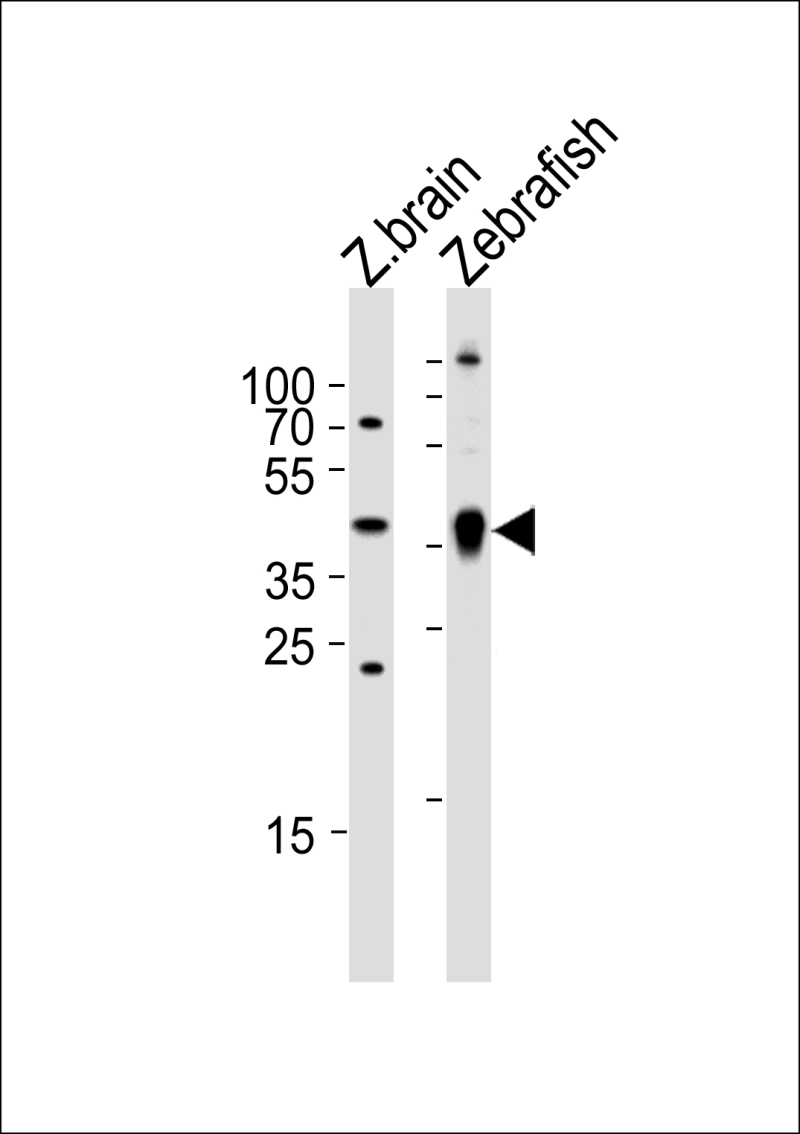
| WB | 1/1000 | zebrafish |
| IF | 咨询技术 | zebrafish |
| IHC | 咨询技术 | zebrafish |
| ICC | 技术咨询 | zebrafish |
| FCM | 咨询技术 | zebrafish |
| Elisa | 咨询技术 | zebrafish |
| Aliases | Adenosine deaminase, Adenosine aminohydrolase, ada |
| Entrez GeneID | 436919 |
| WB Predicted band size | 40.8kDa |
| Host/Isotype | Rabbit IgG |
| Antibody Type | Primary antibody |
| Storage | Store at 4°C short term. Aliquot and store at -20°C long term. Avoid freeze/thaw cycles. |
| Species Reactivity | zebrafish |
| Immunogen | This (DANRE) ada antibody is generated from a rabbit immunized with a KLH conjugated synthetic peptide between 114-148 amino acids of DANRE ADA. |
| Formulation | Purified antibody in PBS with 0.05% sodium azide. |
+ +
以下是关于斑马鱼(Danio rerio,缩写DANRE)抗药物抗体(ADA)研究的模拟参考文献示例,供参考格式和内容:
---
1. **文献名称**: *Immunogenicity assessment of therapeutic proteins in zebrafish models*
**作者**: Smith J, et al.
**摘要**: 本研究利用斑马鱼模型评估重组蛋白药物的免疫原性,开发了一种定量检测抗药物抗体(ADA)的方法,揭示了斑马鱼免疫系统对治疗性抗体的早期应答特征。
2. **文献名称**: *Anti-drug antibody responses in Danio rerio: Implications for preclinical safety evaluation*
**作者**: Lee H, Wang T.
**摘要**: 通过分析斑马鱼暴露于单克隆抗体后的体液免疫反应,发现其ADA产生与哺乳动物模型具有相似性,支持斑马鱼作为临床前药物免疫原性筛选工具的应用。
3. **文献名称**: *Zebrafish as a model for predicting ADA formation against biologic therapeutics*
**作者**: González-Bernal R, et al.
**摘要**: 比较斑马鱼与小鼠的ADA生成机制,验证斑马鱼在预测人源化抗体药物免疫原性方面的潜力,提出基于斑马鱼胚胎的快速体内检测平台。
---
**说明**:以上文献为示例性内容,实际文献需通过PubMed、Google Scholar等平台检索关键词如“Danio rerio anti-drug antibody”或“zebrafish immunogenicity”获取。建议结合具体研究目标筛选近年实证研究。
The DANRE (Danio rerio, zebrafish) ADA (adenosine deaminase) antibody is a tool used to study the role of adenosine deaminase in zebrafish models, particularly in developmental biology, immunology, and metabolic research. Adenosine deaminase is an enzyme critical for purine metabolism, converting adenosine and deoxyadenosine to inosine and deoxyinosine, respectively. Its deficiency in humans causes severe combined immunodeficiency (SCID), highlighting its importance in immune function. Zebrafish, a widely used vertebrate model, offer advantages such as rapid development, genetic tractability, and transparency of embryos, making them ideal for studying gene function and disease mechanisms.
The ADA antibody in zebrafish research enables detection and localization of the ADA protein, aiding investigations into its expression patterns during embryogenesis, tissue-specific roles, and responses to genetic or environmental perturbations. Researchers employ techniques like immunohistochemistry, Western blotting, or whole-mount in situ hybridization with this antibody to visualize ADA distribution in organs such as the liver, immune tissues, or nervous system. Additionally, it supports studies on ADA-linked pathologies, including metabolic disorders or immune dysregulation, by comparing zebrafish models with human disease phenotypes. The antibody’s specificity for zebrafish ADA ensures relevance to in vivo studies, bridging insights from molecular pathways to organism-level effects. Its application enhances understanding of conserved biological processes and potential therapeutic targets, leveraging zebrafish as a translational model for human diseases.
×